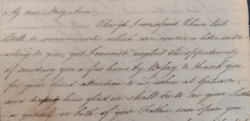Lulu writes: I was very lucky to get work experience at UoB’s History department in June 2023, and as part of my time with Professor Karen Harvey I spent a day transcribing and analysing 18th and 19th century letters. She’d chosen a variety of letters written by children and young people for me, such as … Continue reading “Female friends writing: then and now. A school pupil reflects on their work experience on the ‘Social Bodies’ project”
Old voices, new voices: public engagement using eighteenth-century letters
A thirteen-year-old boy sitting at the back thrusts immediately his hand in the air. It is the end of a two-hour Year 9 workshop on eighteenth-century letters. The final task has been a creative writing exercise. The young people have been invited to write a letter in the voice of Hampton Allen, using early-eighteenth-century language, … Continue reading “Old voices, new voices: public engagement using eighteenth-century letters”
Travelling Letters, Travelling Bodies: Reflections from the Huntington Library
The project team have recently returned from two weeks researching at the Huntington Library in San Marino, California. The Huntington contains several important collections of eighteenth-century British correspondence, many of which found their way across the Atlantic in the early twentieth century, with later waves of acquisitions arriving in more recent decades. Many of these … Continue reading “Travelling Letters, Travelling Bodies: Reflections from the Huntington Library”
George III, the first jubilee, and the making of a modern monarchy
This weekend, the United Kingdom is getting ready for a series of celebrations to mark Queen Elizabeth II’s platinum jubilee. Alongside a number of large-scale ceremonial events, including the trooping of the colour, a royal procession, and an impressive flypast while the royal family are assembled in view of the public on the balcony at … Continue reading “George III, the first jubilee, and the making of a modern monarchy”
One Year On: A database, 1324 letters and 4847 bodies
On 17 March 2021, the first letter was entered into our project database by Sarah Fox. The letter was written by Dorothy Wright, on 31 May 1746, to her daughter Catherine. Dorothy was visiting another daughter who had recently given birth, but she dared not leave because the new mother, ‘is so fearfull she neather … Continue reading “One Year On: A database, 1324 letters and 4847 bodies”
The letter as embodiment of health
‘I think your eyes must be better’, Mary Bostock wrote to Mary Huddleston in May 1810, ‘for I am sure you write as well as ever’. [1] Bostock understood the quality of Huddleston’s handwriting to be a direct indication of her correspondent’s health: she was aware of the subtle changes in how her relative formed … Continue reading “The letter as embodiment of health”
‘I am glad to write to you’: children’s letters in 18thC England
York City Archives, Gray GRF/4/3 J.16 In 1809, Jonathan Gray of Gray’s Inn in York signed off a letter to his wife, Mary with these words to his two year old son: ‘Father hopes William is a good boy, and minds his Book’. This sentence is clearly printed in large block letters and is followed … Continue reading “‘I am glad to write to you’: children’s letters in 18thC England”
Picturing the Body: Body Parts in eighteenth-century Letters
All images have been reproduced with kind permission of © British Library Board The past few weeks have seen the reopening of archives and libraries across the country, and, happily for the project team, the opportunity to be reunited with the eighteenth-century letters at the heart of our research. But with archive slots in high … Continue reading “Picturing the Body: Body Parts in eighteenth-century Letters”
Spirited Communication
Mr Backhouse is ‘in great spirits’ about the price of Cotton,[1] while Mrs Earle’s spirits are ‘much improved’[2]. John Eliot needs to rest his ‘distressed spirits’[3], but easiness with his family keeps Samuel Wesley’s ‘spirits from sinking’.[4] Meanwhile Anna Maria Allwood has spotted ‘the Spirit’ battling with ‘the Old Man of Sin[5] and Joseph Munby … Continue reading “Spirited Communication”
What Letters Did, What Letters Do
I am surrounded by letters on all sides. Our project, ‘Material Bodies, Social Identities: Embodiment in British Letters c.1680- 1820’ funded by the Leverhulme Trust began in February 2021. Our aim? To explore descriptions of everyday experiences of the body in the context of the communities of family and kin, friendship and faith. What role … Continue reading “What Letters Did, What Letters Do”

